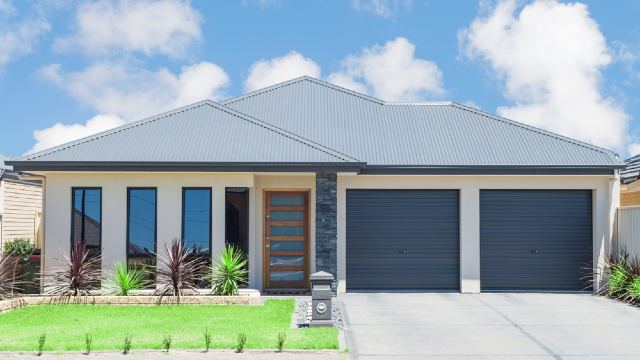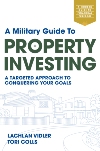In this edited extract from their book, A Military Guide to Property Investing, Lachlan Vidler and Tori Colls share the five key reasons they believe established properties are a better option than new properties.
It’s one of the greatest debates in residential property investment – which provides superior investment potential: new or established property? We have a very strong bias towards established property. We will take you through some of the reasons why below, but above all else, established property has worked well for our portfolio and those of our clients. Some people have done well with portfolios based on purchasing new property, but we would argue that in general terms, established will outperform new.
1. Supply and demand
One of the biggest reasons we believe in established properties over new properties is supply and demand. While there are lots of factors that underpin property price growth, fundamentally, supply and demand is what it all boils down to. Unfortunately for new property, the supply side of the equation is out of balance.
Most new properties are built in large property estates, where most of the other properties are new as well. As sales rise, developers will continuously list more and more plots of land for sale. This means that developers control the supply of properties in the market. If there is no demand, developers just don’t list properties for sale. When demand begins to rise, developers continue to release properties until the demand has been satisfied. This means that it is very difficult for natural market pressure, which drives up property prices, to occur – it is all in the hands of the developer.
2. Location
Our next reason is location. Major cities have already been built out from the centre, and there are generally no opportunities close to the centre for developers to purchase large parcels of land to then develop into estates. Developers are required to purchase their large parcels of land on the outer fringes of cities, because that is the only place where this volume of land is now available. This means that those living in these outer-fringe suburbs are far away from CBDs, quality schools, renowned shopping areas and transport hubs.

3. Depreciation
There are several mathematical reasons to choose established over new properties. Let’s start with depreciation. Developers of new properties will continuously push the benefits of depreciation upon interested buyers. However, as an investor, you know that you should be looking to purchase a high-value, appreciating asset, not a depreciating liability. Although tax depreciation may seem attractive (and your tax return may put a few extra thousand dollars back in your pocket), property investors want to spend as little money as possible on a depreciating asset.
For both new and established properties, it is paramount to remember that the value of the asset is in the land – not in the build. Let’s look at a hypothetical example, illustrated in the tables below.
Value – example established property
| Total value of the property | $600,000 |
|---|---|
| Land value | $375,000 |
| House value | $225,000 |
Value – example new property
| Total value of the property | $600,000 |
|---|---|
| Land value | $225,000 |
| House value | $375,000 |
Both properties are the same value, however the new property will have the ‘depreciation benefits’, as marketed by the developer, attached to the new $375,000 house. What buyers don’t see is that they are purchasing a property that has a reduced land value ($225,000) when compared to the asset of the existing property ($375,000).
Always remember: the value is in the land. This is why house and land packages are sold on significantly smaller pieces of land than established properties – with tiny front and back yards. Developers know that the value is in the land, so they attempt to divide it up as much as possible in order to put more dwellings on it and sell to more buyers who are captivated by the beautiful, brand-new property and the glossy brochures. When buyers inspect new properties in freshly established estates, they are generally too busy looking at the huge amount of ‘house’ they are getting for their money, rather than being concerned with the lack of land in the front, back and side yards.
Let’s look at our example again.
Value and result – example established property
← Mobile/tablet users, scroll sideways to view full table →
| Total value of the property | $600,000 | |
|---|---|---|
| Land value | $375,000 | More of your money is going to the asset |
| House value | $225,000 | Less of your money is going to the liability |
Value and result – example new property
← Mobile/tablet users, scroll sideways to view full table →
| Total value of the property | $600,000 | |
|---|---|---|
| Land value | $225,000 | Less of your money is going to the asset |
| House value | $375,000 | More of your money is going to the liability |
If you buy a new property, more of your money is purchasing a liability rather than an asset that will grow over time and provide you with scalable capital gains.
Another point to note is that whenever you purchase a new house and land package, there will be a developer’s fee hidden within the purchase price. Buyers of new properties need to be aware that they will rarely pay fair market price for a new build. Developers have to earn their money from somewhere, right?
4. Capital gains
Now, let’s use our example to look at the appreciation of the two different properties. Let’s analyse the example after 10 years of growth, during which time we’ll assume that the properties’ value will have doubled, and that the buildings will have depreciated at the same rate of 15% each.
Value after 10 years – example established property
| Land value | $750,000 | Asset |
|---|---|---|
| House value | $191,250 | Liability |
| Total value | $941,250 | An increase of $341,250 |
Value after 10 years – example new property
| Land value | $450,000 | Asset |
|---|---|---|
| House value | $318,750 | Liability |
| Total value | $768,750 | An increase of $168,750 |
The difference in the appreciated value of the two properties is $172,500.
As you can see, after appreciating the land and depreciating the property, the established property is in a league of its own, while the new property has fallen behind in value. This illustrates the importance of land value and ensuring that your future property investments have enough of it.
5. Tax benefits
Now, let’s tackle the ‘tax benefit’ argument for new properties. Developers and other investors who choose new properties over established ones will often say, “Just think about all of the tax benefits for the new property! Established property buyers certainly don’t reap those benefits.”
This is correct – if you count spending money as a ‘benefit’. Remember, as an investor you want to see your asset appreciating while pocketing as much cash as possible, not spending it or seeing it diminish over time. As you can see in the previous examples, the land of the established property is appreciating at a rate that a new property’s ‘tax benefits’ could simply never keep up with. We would be surprised if any investor could claim $172,500 worth of tax depreciation, even at the highest marginal tax rate of 45%.
Again, the value in property is in the capital gains, not in the alleged ‘tax savings’.
As you can see, established property will mathematically outperform new properties and this is why we personally choose to bolster our portfolios with high-performing, established properties.

Cover image source: Flotsam/Shutterstock.com
Compare Home Loans with Canstar
Lowest interest rates for 1-year fixed home loans
The comparison table below displays some of the 1 year fixed rate investment home loan products on Canstar’s database with links to lenders’ websites available for a loan amount of $350,000 at 80% LVR in NSW, and available for Principal and Interest repayments. The results are sorted by comparison rate (lowest to highest), then by provider name (alphabetically). Before committing to a particular home loan product, check upfront with your lender and read the applicable loan documentation to confirm whether the terms of the loan meet your needs and repayment capacity. Use Canstar’s home loans comparison selector to view a wider range of home loan products. Canstar may earn a fee for referrals.
*Comparison rate based on loan amount of $150,000. Read the Comparison Rate Warning.
Lowest interest rates for 3-year fixed home loans
The comparison table below displays some of the 3 year fixed rate investment home loan products on Canstar’s database with links to lenders’ websites available for a loan amount of $350,000 at 80% LVR in NSW, and available for Principal and Interest repayments. The results are sorted by comparison rate (lowest to highest), then by provider name (alphabetically).Before committing to a particular home loan product, check upfront with your lender and read the applicable loan documentation to confirm whether the terms of the loan meet your needs and repayment capacity. Use Canstar’s home loans comparison selector to view a wider range of home loan products. Canstar may earn a fee for referrals.
*Comparison rate based on loan amount of $150,000. Read the Comparison Rate Warning.
Lowest interest rates for 5-year fixed home loans
The comparison tables below displays some of the 5 year fixed rate investment home loan products on Canstar’s database with links to lenders’ websites available for a loan amount of $350,000 at 80% LVR in NSW, and available for Principal and Interest repayments. The results are sorted by comparison rate (lowest to highest), then by provider name (alphabetically).Before committing to a particular home loan product, check upfront with your lender and read the applicable loan documentation to confirm whether the terms of the loan meet your needs and repayment capacity. Use Canstar’s home loans comparison selector to view a wider range of home loan products. Canstar may earn a fee for referrals.
*Comparison rate based on loan amount of $150,000. Read the Comparison Rate Warning.
About Lachlan Vidler and Tori Colls

Lachlan Vidler is the Director of Atlas Property Group, a buyer’s agency that connects home buyers and investors with quality property. He started his career as an Officer in the Royal Australian Navy. An avid investor himself, Lachlan has amassed an impressive property portfolio.

Tori Colls is a founding member of Atlas Property Group. A former Royal Australian Air Force Officer, she is passionate about helping everyday Australians achieve financial freedom through property. She has grown her own property portfolio to hold a number of assets in both metropolitan and regional centres.
Thanks for visiting Canstar, Australia’s biggest financial comparison site*
